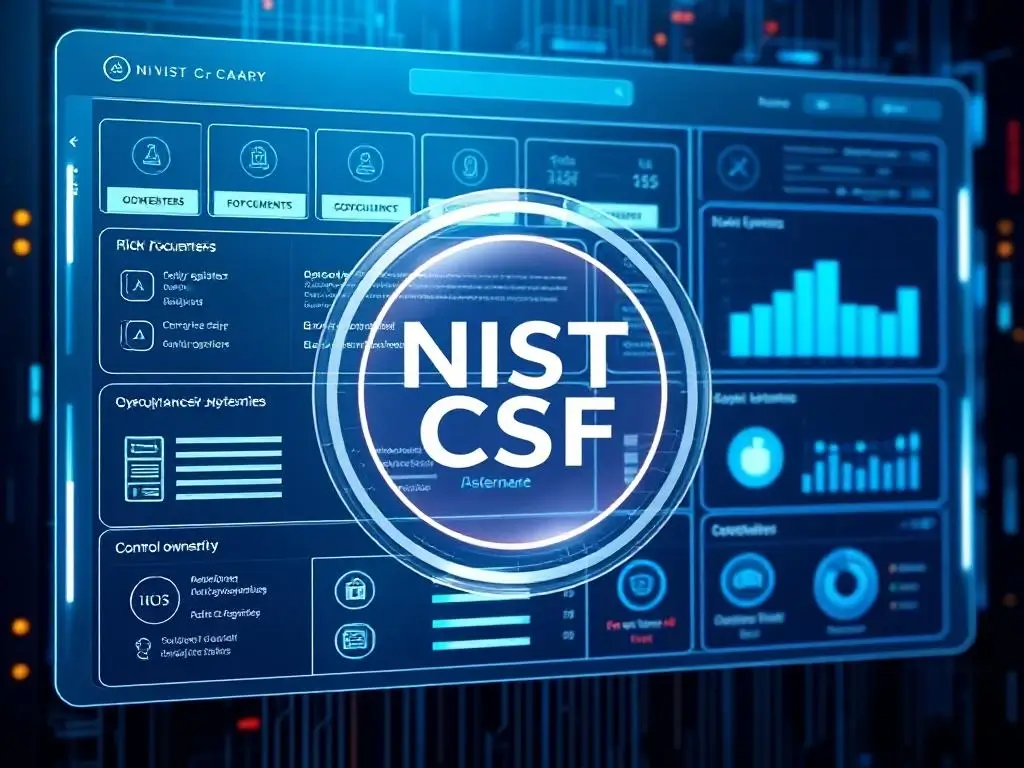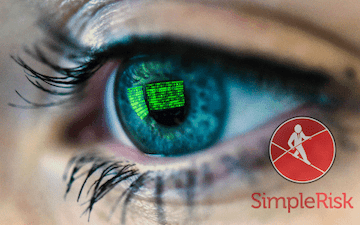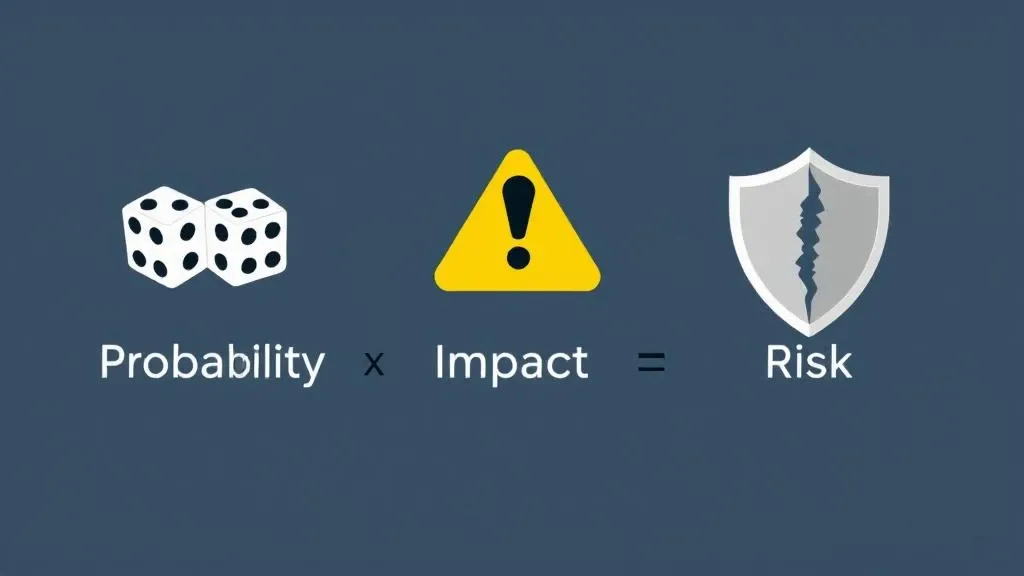Cyberattacks soared 75 % in Q3 2024, averaging 1,876 hits per organization (Check Point Research). Compliance rules ballooned at the same time. The result is security teams juggle sprawling spreadsheets instead of fixing threats. SimpleRisk brings every risk, control, and policy into one dashboard, so you spend time reducing risk—not hunting for data.
The NIST Cybersecurity Framework (CSF) is still the industry’s go-to playbook. It divides security work into five Functions—Identify, Protect, Detect, Respond, Recover—and drills those into specific outcomes.
This post shows exactly where SimpleRisk lets you tick off NIST CSF controls out of the box, and where you’ll still need other tools or processes.
The Identify Function: Building a Foundation
The Identify function focuses on understanding your organization’s environment, assets, business context, and risk profile. SimpleRisk shines in this function by providing tools to document assets, assess risks, and establish governance.
For example:
- ID.AM-1 (Physical devices and systems are inventoried) and ID.AM-2 (Software platforms and applications are inventoried) are partially supported. SimpleRisk allows you to link assets to risks and controls, enabling tracking of key systems, but it does not function as an automated asset inventory tool.
- ID.GV-1 (Organizational cybersecurity policy is established and communicated) is fully supported. SimpleRisk provides a policy management module where you can create, store, track versions, and assign ownership for cybersecurity policies.
- ID.RA-3 (Threats, vulnerabilities, likelihoods, and impacts are identified) is fully supported through SimpleRisk's core risk assessment workflows. Users can document risks, evaluate threats and vulnerabilities, and calculate likelihood and impact to prioritize mitigation efforts.
In total, SimpleRisk addresses most of the Identify controls through its risk register, asset linkages, policy management, and reporting capabilities. Automated discovery of assets or vulnerabilities would require integration with other tools.
At the end of the Identify function, it's clear that SimpleRisk adds value by streamlining documentation, policy management, and risk assessment processes aligned with this function.
The Protect Function: Documenting Safeguards
The Protect function focuses on the development and implementation of safeguards to ensure critical services delivery. SimpleRisk supports this function primarily by enabling policy and procedure documentation, assigning ownership of controls, and tracking mitigation plans.
Notable mappings include:
- PR.AT-1 (All users are informed and trained) and PR.AT-2 (Privileged users are trained) are both supported through the ability to track security awareness training policies and evidence.
- PR.IP-1 (Baseline configuration policies are established) is fully supported via the policy management module, enabling documentation of baseline configurations and related standards.
- PR.IP-3 (Configuration change control processes are in place) is also supported through documenting change management policies, though SimpleRisk does not enforce change control technically.
SimpleRisk does not directly implement technical controls (e.g., firewalls, access controls), but provides the governance layer to document, assign, and track these controls, their owners, and their review schedules.
At the end of the Protect function, SimpleRisk adds value by enabling comprehensive documentation and accountability for safeguards.
The Detect Function: Supporting Detection Documentation
The Detect function is centered on timely discovery of cybersecurity events. SimpleRisk supports this function by enabling organizations to document detection controls and procedures, assign responsible parties, and track evidence of control performance.
Examples:
- DE.DP-1 (Detection processes and procedures are maintained and tested) is fully supported by allowing documentation of detection-related controls, procedures, and testing schedules.
- DE.CM-1 (Network is monitored to detect events) is partially supported. While SimpleRisk does not perform technical monitoring, it enables documentation and assignment of responsibilities for monitoring activities.
This pattern holds true across most Detect controls: SimpleRisk documents the existence of controls and processes, assigns ownership, and tracks periodic reviews—but actual monitoring and detection are performed by technical security tools.
At the end of the Detect function, SimpleRisk adds value by ensuring documentation and accountability of detection processes.
The Respond Function: Enabling Incident Response Governance
When it comes to incident response, SimpleRisk plays an important role in establishing, maintaining, and reviewing incident response plans and roles.
Key mappings include:
- RS.RP-1 (Response plan is executed during or after an incident) is fully supported by storing and version-controlling your incident response plan within SimpleRisk.
- RS.CO-1 (Personnel know their roles and order of operations in incident response) is supported by documenting roles and responsibilities and linking them to controls.
- RS.IM-1 (Response plans are improved based on lessons learned) is supported through control reviews, audit findings, and action tracking within the platform.
SimpleRisk tracks the governance and documentation aspects of incident response, providing a central repository for plans, assignments, and improvements.
At the end of the Respond function, SimpleRisk adds value by serving as a central hub for managing, reviewing, and improving incident response governance.
The Recover Function: Documenting Recovery Processes
Finally, the Recover function addresses plans for resilience and restoring capabilities after a cybersecurity incident.
SimpleRisk mappings include:
- RC.RP-1 (Recovery plan is executed during or after an incident) is fully supported through recovery plan documentation.
- RC.IM-1 (Recovery plans are improved by lessons learned) is supported similarly to incident response improvements, via documentation updates and control reviews.
SimpleRisk provides the structure to manage recovery documentation, ownership, and reviews—ensuring continuous improvement and readiness.
At the end of the Recover function, SimpleRisk adds value by maintaining recovery governance and supporting continuous improvement.
What SimpleRisk Doesn’t Do (and How to Address It)
While SimpleRisk provides comprehensive coverage for governance, documentation, ownership, and risk management functions across the NIST CSF, there are areas where additional tools are needed to fully implement the framework:
- Automated asset discovery (e.g., ID.AM-1, ID.AM-2) would require integration with a CMDB or asset management platform.
- Technical control enforcement (e.g., PR.AC-1 access controls, DE.CM-1 monitoring) must be implemented with firewalls, endpoint protection, SIEM, and related security technologies.
- Continuous monitoring and real-time alerting are outside SimpleRisk’s scope.
SimpleRisk acts as the governance and accountability layer, enabling organizations to document, assign, track, and improve their controls and risks over time. Integrating SimpleRisk with other security technologies or processes completes the picture.
Conclusion: SimpleRisk as a Foundation for NIST CSF Alignment
Key benefits SimpleRisk provides for NIST CSF alignment include:
- Centralized documentation of policies, controls, and risks
- Assignment and tracking of control ownership and accountability
- Version control and audit trails for continuous improvement
- Evidence tracking for compliance reporting
- Integration readiness with technical control tools
Mapping SimpleRisk to the NIST Cybersecurity Framework reveals that the platform is highly effective at enabling organizations to manage the governance, documentation, ownership, and improvement of cybersecurity controls. While it does not replace technical security controls, SimpleRisk provides a central hub to document policies, assign control ownership, track compliance evidence, and manage the lifecycle of risks and mitigations.
For organizations adopting the NIST CSF, SimpleRisk offers a practical and accessible platform to address many of the framework’s controls, especially in the Identify, Protect, Respond, and Recover functions. With integration or complementary tools for technical controls, SimpleRisk can help you build a holistic cybersecurity program aligned with NIST best practices.
Here's a list of NIST CSF controls covered by SimpleRisk:
| NIST CSF ID | Control Description | SimpleRisk Coverage |
|---|---|---|
| ID.AM-1 | Physical devices and systems are inventoried | ✳️ Supports indirect tracking via linking assets to risks; not an automated inventory system |
| ID.AM-2 | Software platforms and applications are inventoried | ✳️ Supports indirect tracking via asset metadata |
| ID.AM-5 | Resources (e.g., hardware, devices, data, personnel, facilities) are prioritized based on their classification | ✅ Supports risk prioritization and classification in risk register |
| ID.BE-1 | Organization’s role in supply chain is identified and communicated | ✅ Documented in policy and governance records |
| ID.BE-3 | Organization’s place in critical infrastructure and dependencies is established | ✅ Captured in organizational risk records and contextual documentation |
| ID.GV-1 | Organizational cybersecurity policy is established and communicated | ✅ Policy management and tracking in documentation module |
| ID.GV-2 | Cybersecurity roles and responsibilities are coordinated and aligned | ✅ Assigned ownership of risks, controls, and mitigation actions |
| ID.RA-1 | Asset vulnerabilities are identified and documented | ✅ Risk register supports documenting vulnerabilities linked to assets |
| ID.RA-2 | Cyber threat intelligence is received and analyzed | ✳️ Supports documenting threat intel as risk sources or notes; not automated |
| ID.RA-3 | Threats, vulnerabilities, likelihoods, and impacts are identified | ✅ Core function—risk assessment records threats, vulnerabilities, likelihood, impact |
| ID.RA-4 | Potential business impacts are identified | ✅ Included in risk assessment (impact ratings, business objectives mapping) |
| ID.RA-5 | Risk responses are identified and prioritized | ✅ Tracks mitigation plans, risk acceptance, transfer, avoidance, treatment |
| ID.RM-1 | Risk management processes are established and agreed upon | ✅ Governance and policy documentation plus risk process configurations |
| ID.RM-2 | Organizational risk tolerance is determined and clearly expressed | ✅ Captured in risk scoring methodology and acceptance thresholds |
| ID.RM-3 | Risk management is part of organizational decision making | ✅ Reporting and dashboards provide input for governance decisions |
| PR.AT-1 | All users are informed and trained | ✅ Policy documentation and evidence tracking for awareness/training programs |
| PR.AT-2 | Privileged users are trained | ✅ Same as above; documentation of role-based training requirements |
| PR.IP-1 | Baseline configuration policies are established | ✅ Policy management module stores baseline documentation and version control |
| PR.IP-3 | Configuration change control processes are in place | ✅ Documentation of change management policies; not automated enforcement |
| PR.IP-4 | Backups are performed, maintained, and tested | ✅ Policy documentation tracking backup strategy; operational execution external |
| PR.IP-6 | Data protection processes are maintained | ✅ Documenting data protection policies and procedures |
| PR.IP-7 | Continuous improvement is incorporated into protection processes | ✅ Tracking of control reviews, audit findings, and improvements |
| PR.IP-8 | Vulnerability management plan is developed and implemented | ✅ Documenting and tracking vulnerability management process in risk/control register |
| DE.DP-1 | Detection processes and procedures are tested and maintained | ✅ Policy documentation; periodic control reviews and testing evidence tracking |
| DE.CM-1 | Network is monitored to detect events | ✳️ Indirect: documents control existence but does not perform monitoring |
| DE.CM-3 | Personnel activity is monitored to detect anomalies | ✳️ Policy and procedural documentation only |
| DE.CM-8 | Vulnerability scans are performed | ✅ Documentation of scanning schedule, responsible parties, and results |
| RS.RP-1 | Response plan is executed during or after an incident | ✅ Incident response plan stored and managed as a documented policy |
| RS.CO-1 | Personnel know their roles and order of operations in incident response | ✅ Roles and responsibilities documented and assigned |
| RS.CO-2 | Incidents are reported consistent with criteria | ✅ Incident reporting process documented and tracked |
| RS.IM-1 | Response plans are improved based on lessons learned | ✅ Audit findings, incident reviews, and continuous improvement tracking |
| RS.IM-2 | Response strategies are updated | ✅ Same as above; version-controlled documentation |
| RC.RP-1 | Recovery plan is executed during or after an incident | ✅ Recovery plan documented and tracked |
| RC.IM-1 | Recovery plans are improved by lessons learned | ✅ Post-incident reviews and plan updates documented in platform |
| RC.CO-1 | Public relations are managed | ✅ Communication policies documented; operational PR execution external |





